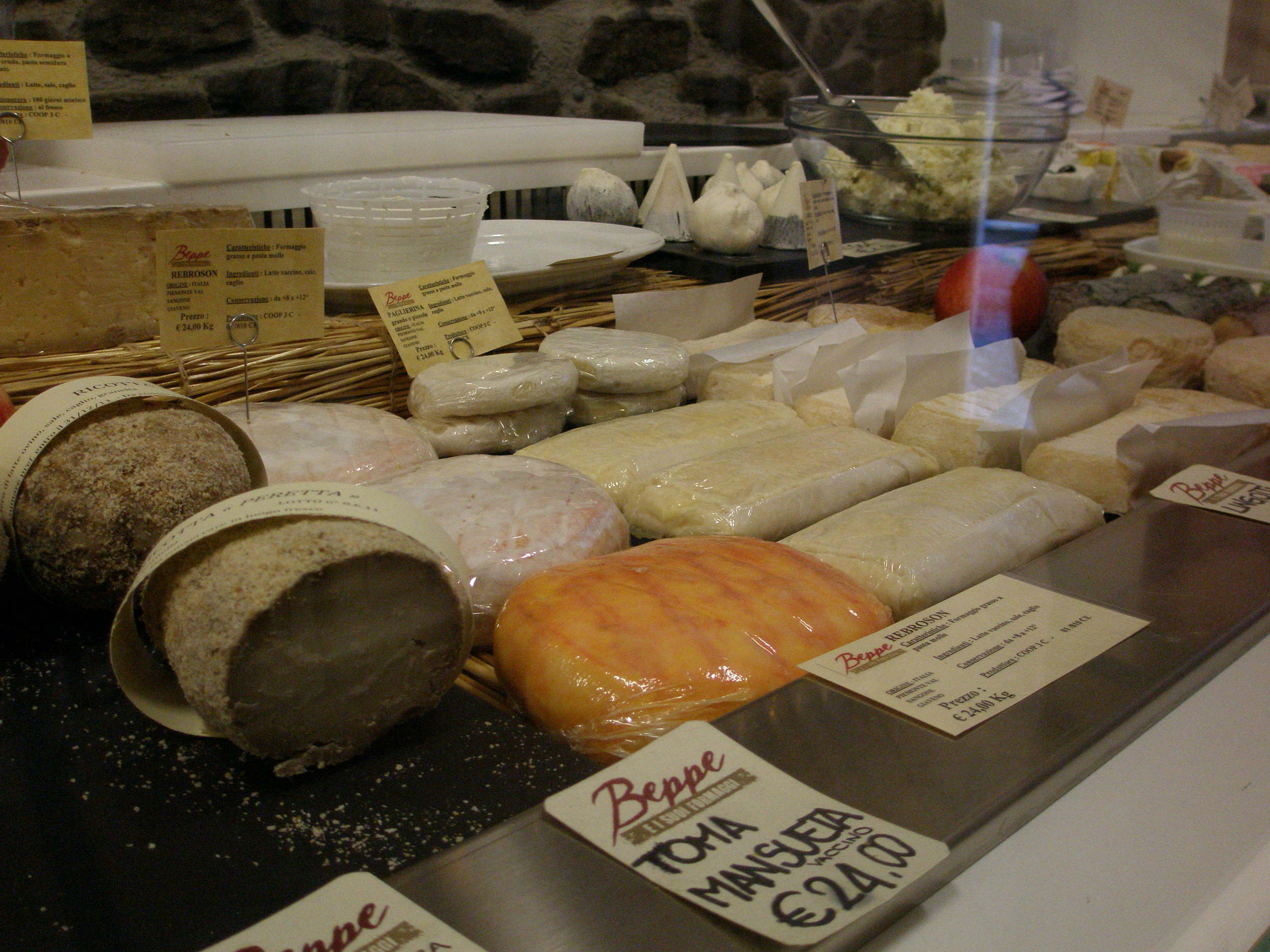A visit to your local cheesemonger, if you’re lucky enough to have one worthy of the name, can be a many splendored thing. A good cheese counter is not necessarily the one with the most cheeses or the most expensive cheeses. A good cheese counter has one or several people behind (or in front of) it who delight in introducing you to a new cheese, finding the perfect cheese for the occasion, and maintaining (curating, even) an assortment of cheeses to satisfy any range of discerning and curious customers. A delightful cheese (en)counter this afternoon prompted me to think about five amazing cheese counters that have been crucial in my enculturation (hehe) as a major turophile. Obviously, a childhood full of good Wisconsin cheddar and a few months making and selling cheese did plenty to feed my obsession, but today I offer to you a brief history of my ongoing love affair with cheese and cheesemongers.
1. Formaggio Kitchen, Cambridge, MA ca. 2009
While my college years saw my discovery of the delights of Indian food, the inexhaustible range of craft beers, the joys of semi-disorganized wine tasting (Floreat Eliot House Wine Society!), one of the most culinary life-changing experiences during my time in Cambridge might have been a series of bike rides down Huron Avenue to the renowned Formaggio Kitchen. Leading the way was my initiator into the world of MFK Fisher, IPAs, and ripe cheeses, one Zach A. We lock our bikes outside and enter a small storefront packed with all that is good in the world. A cheese and deli counter in the first room, stacked high with rounds and wedges, flags denoting age and provenance sticking out, almost grazing the bottoms of the whole hams and salamis hanging from the ceiling. Zach, having worked at a cheese counter back in Philly, took charge, speaking with the cheesemonger with authority, tasting, questioning, selecting the perfect cheeses for our needs. It was the first time I had seen such a thing. Sampling five cheeses to choose two? It seemed revolutionary. In return visits, Zach continued to be the vocal, knowledgeable interlocutor, but slowly, as with beer, wine, and ethnic food, I began to learn my tastes and the language necessary to convey those tastes to the person across the counter.
2. Pastoral Artisan Cheese, Chicago, IL ca. 2011
The year after college, living with three lovely ladies in a lovely lakeside neighborhood in Chicago. Local cheese counter only three short blocks away. Periods of employment, underemployment, unemployment, and overwork. Whether I was just looking to spend a few dollars on an afternoon treat or shopping for the perfect accompaniments to our midwestern iteration of Wine Society, the cheesemongers were always ready to find the right cheese. Not quite as overwhelming as Formaggio, the smaller scale of the counter meant that on a quiet Thursday afternoon I felt comfortable enough to ask a few questions, taste a few cheeses, and make a purchase. No stranger to budgets, these young mongers were always willing to cut me a tiny slice of an expensive cheese, and I grew to enjoy going in with a specific question. What will pair with the dry German wine I have in the fridge? What about my beet chutney? My enthusiasm for Pastoral was only briefly dimmed when I interviewed for a job as a cheese counter attendant and was rejected after a three-hour “stage,” including a pop quiz at the end in which I was expected to name and describe all of the cheeses I’d tasted. But in the end, every occasion was an occasion calling for cheese.
3. La Cave a Fromage, South Kensington, London, ca. 2012
My nine months in Europe was full of unforgettable cheese experiences. That fresh pecorino sandwich shared with two friends sitting in the stoop of a centuries-old house during the annual chestnut festival. I’ve been trying to relive that cheese for the two years since with no luck at all. Funky talleggio, heavenly burrata, creamy gorgonzola dolce, farmstead toma. Freshest mozzarella di buffala straight from Naples eaten with the greenest, zestiest olive oil from olives that only three days before I had stripped by hand from the laden branches of a gnarled tree. In South Kensington, I learned to ask my now-favorite question: what’s ripe? I confirmed a long-held suspicion that there are few cheeses that I will not eat with some gusto, and that true cheese connoisseurship can become a very expensive undertaking. I discovered that I relish a soft-ripened cheese right on the brink of spoilage, when the insides ooze slowly at cellar temperature and faster in a warm kitchen, eaten in (I imagine) a French style, daubed on an airy, crusty baguette. The cheesemonger knows which cheese is at its prime and which is about to pass it, and sometimes they’ll even cut you a deal on the very ripest.
4. Rubiner’s Cheesemongers, Great Barrington, MA, ca. 2013
During my stint last season at Chubby Bunny, every other Friday was payday, which meant every other Friday involved a trip up to Great Barrington to deposit our paychecks and go out on the town. Sometimes this involved live music and a beer at the Gypsy Joynt, sometimes sourdough pizza and beer at Baba Louie’s, sometimes a quick pass through the co-op before heading back out of the Berkshires into the wilds of northwest Connecticut. When we got to town before six, that meant a duck into Rubiner’s before closing time. A smallish fancy shop in a partly-fancy smallish town, the visits to this cheese counter were less about the actual cheesemonger and more about the farmstead products for sale around the counter. Not that I was actually buying much (again, fancy store), but I was definitely taking mental notes. Cured Italian salamis the size of your thumb for $2 a pop - quick to cure, easy to sell at a farmers market! The rustic-chic aesthetic that accompanies a local artisan product for top-dollar. Rubiner’s offers a farmer discount, which is novel and much-appreciated, but more important for me than my meager purchases was the food for thought about my own potential approach to marketing my products. Can I sell a few things to rich people at justifiably high prices while growing the majority of my food for a local customer base at affordable prices? Every cheese counter, gourmet shop, co-op, and farmers market stand is now a study in image, aesthetics, labeling, and marketing.
5. Zingerman’s Delicatessen, Ann Arbor, MI, ca. 2014
In my many trips back and forth across the eastern half of this expansive country, I’ve made it a habit to punctuate the drive with a few days in Ann Arbor, thanks to the presence of Bianca, almost-doctor, appreciative food audience, and official photographer. Each trip was marked with a visit to Zingerman’s to marvel at the selection, taste a few cheeses and make a small but delicious purchase. Now, as my winter in Ann Arbor comes to a close, it seemed only fitting to celebrate with cheese. So, on this cold but sunny Tuesday afternoon, we walked in with a mission, and the cheesemonger was happy to accept it. We wanted to have a great little (indoor) picnic for $30 or less, mostly cheese, a smidge of meat. “Are you in a hurry?” Asked a totally dedicated Ben. Over half an hour later we had sampled a handful of cheeses and narrowed it down to the perfect combination that combined my love for soft, gooey, or funky cheese with Bianca’s preference for hard, nutty, Alpine-style cheeses. He sliced us the most delicate of slices in keeping with our budget. We sampled olives, and took a bit of two different kinds. He tried to sell us cipollini in balsamic, but my homemade ones were better. I sampled cured ham, including a slice of Jamon Iberico that I believe is the closest to gustatory perfection anything has ever been. (Ben said when I finish my first permaculture prosciutto, I should bring some by for a tasting.) A thin-sliced paesano roll completed the spread, and when we went to pay, we discovered that we’d stuck exactly to our budget! $29.56, which delighted Ben just as much as it had us when we gave him one last good-bye on the way out the door.
Today’s visit to Zingerman’s was everything one could want from a visit to a cheesemonger, and much more. He listened to our needs, assessed our divergent tastes, cut generous samples and watched for our eyes to light up as we tried each new cheese. He was enthusiastic in sharing his passion and knowledge, and seemed genuinely interested in hearing about my salumi experiences and farm dreams. He even deferred to a more experienced hand-slicer to ensure beautiful thin slices of country ham. How many times can you say you went shopping and came back elevated, inspired, satiated, and even surprised? I think it’s time for a trip to your local cheese counter, if you’re lucky enough to have one.






